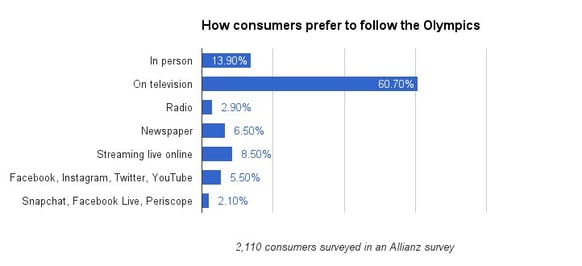Every four years, The Olympic Games rolls around and provides one of the most dramatic sporting extravaganza of the summer. And of course, all the major players in the world of sports, and the media want a piece of the action.
Pre and post Olympics interest for online broadcasts
Although this may be the case, not many people were expected to tune in via OTT during the Rio games. In fact, expectations were quite low.
According to a survey published by Allianz prior to this year's Olympics, only 5.5% of consumers said they would watch the action through a live stream, whereas a whopping 60.7% confirmed that they would be tuning into traditional television coverage.

Well, the results were staggering...
According to Nielsen, the first ten days of the action at the 2016 Rio Olympics saw more than two billion minutes (that's 33 million hours) of online viewership.
To put that into perspective, those viewing numbers are more than the 1.46 billion minutes streamed during the 2012 Summer Olympics in London and the 2014 Winter Olympics in Sochi combined. Amazing to say the least.
This growth in online viewing figures is a real testament to the rising power of OTT live streaming in the sporting world.
Moving from linear
Speaking to the New York Times, Ryan Eckel, Vice President of brand marketing at Dick’s Dick’s Sporting Goods (a first time advertiser at The Olympics), has an interesting take on the matter:
“We’re trying to look at it as video, and not think about whether it comes through cable or the internet or a linear broadcast,” Mr Eckel said. “I know I’m just as likely to watch the Games on the app on my Apple TV as I am on the linear broadcast.”
It seems that over time, streaming and television views could almost be treated similarly for the huge sporting events, especially as more advertisers are trying to compete for digital space.
Now, the 2012 London Olympics was the first truly digital Olympics, pushing the envelope of innovation further than ever before in terms of unique content and multi-platform engagement.
Second-screen engagement as a trend
Despite initial scepticism, this year's Olympics took fan engagement to a whole new level with the phenomenon of second screen engagement.
According to a study by Global Web Index, smartphone and second-screen usage is now the norm across a broad demographic range, with 85% of Olympic viewers using subsequent devices as they follow the action while watching TV.
Second screen apps offer audiences vital stats, tailored content and an additional dimension of experience while watching the action live, and this summer, it was a massive success.
Creating space for targeted ads and sponsorships, second-screen applications can create an immediate return on investment while building a significant online audience - a match made in heaven.
The Rio games were clouded by their fair share of controversy, but in the end, it turned out to be a historic sporting spectacle revered by many the world over. Much of this is down to the standard of the athletes, but the presence of OTT and the excitement it certainly added to the event.
OTT and live sports go hand-in-hand, and as more people are beginning to realise the potency of its power, it can only go from strength to strength.
Interested in broadcasting sports events online? Learn how you can set up an event live stream with Cleeng:




